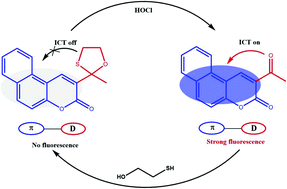A benzocoumarin-based fluorescent probe for ultra-sensitive and fast detection of endogenous/exogenous hypochlorous acid and its applications†
Abstract
Hypochlorous acid (HOCl) is widely used in daily production and life because of its green and strongly oxidizing properties. Additionally, as a vital reactive oxygen species (ROS), it is an innate immune system weapon and performs a critical function in many pathophysiology processes. In this paper, a novel water-soluble fluorescent probe, BMH, with excellent performance is designed and synthesized by simple condensation of benzocoumarin and 2-mercaptoethanol. BMH has specific selectivity, excellent sensitivity, ultra-fast response (<3 s), and a wide pH detection range. The fluorescence intensity of BMH has an excellent linear correlation with the concentration of HOCl in the scope of 0–10 μM, and the calculated detection limit (DL) is 2.45 nM. The intramolecular charge transfer (ICT) sensing mechanism of BL has been verified by fluorescence, UV, and MS studies as well as density functional theory (DFT) calculations. Furthermore, BMH can be incorporated into a solid-state visual sensor to detect HOCl conveniently. BMH was applied to detect HOCl-spiked actual water samples and achieved satisfying recovery rates. Also, the low-toxicity BMH can be successfully used to track changes in endogenous/exogenous HOCl in living cells. In short, BL provides a robust and reliable monitoring tool to reveal the biological functions of HOCl and ensure its safe use.



 Please wait while we load your content...
Please wait while we load your content...